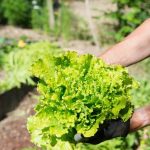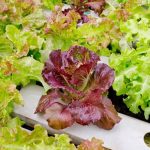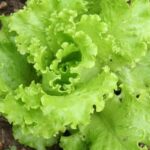Introduction
Ground cover in a vegetable garden offers several benefits, including increased water retention in the soil and reduced weeds. It also helps to prevent soil erosion and compaction and can even help to keep pests away. Ground cover is an important part of any successful vegetable garden and choosing the right one can make a big difference. Some of the best ground covers for vegetable gardens include mulch, grass clippings, shredded leaves, pebbles, gravel and wood chips.
Mulch is often considered to be the best ground cover for vegetable gardens as it prevents weeds from growing, helps retain moisture in the soil, adds organic material to improve fertility and increases beneficial microorganisms in the soil. Mulches such as straw or wood chips are both effective although wood chips may need to be replaced more often due to decomposition.
Grass clippings can provide added nutrients to help fertilize your garden beds but there’s no way of knowing what kind of chemical exposure your lawn may have received so it is important to source clippings from an untreated lawn when possible. They will also start decomposing quickly so they must be replenished regularly.
Shredded leaves are another good choice for retaining moisture while more colorful options such as pebbles or gravel can provide additional aesthetic value along with their practical functions. Wood chips tend to need more frequent replacing due to decomposition but they still remain one of the most popular types of ground cover due to their eco-friendly status and overall effectiveness at suppressing weeds below leading crops above and protecting them from too much sun exposure which could impede growth or cause damage.
What is Ground Cover?
Ground Cover, also known as a groundcover, is a layer of vegetation that covers the soil surface in a garden. This layer helps to reduce erosion, ensure that the soil remains moist, and provide habitat for beneficial insects. Groundcovers may include grasses, herbs, shrubs, flowering plants, and annuals. They can also be ground-nesting birds or other animals. Depending on the type chosen, ground cover can serve many different functions in the garden, such as providing food or acting as a living mulch to suppress weeds. In addition to its functional benefits within the garden ecosystem, ground cover adds visual appeal by creating colorful carpets of vegetation that enhance and highlight other elements of the landscape.
Different Ground Cover Options for Vegetable Gardens
Many vegetables will benefit from having a layer of ground cover in the garden. Ground covers provide many benefits for vegetable gardening, including weed suppression, temperature moderation, and erosion prevention. Fortunately, there are many different types of ground covers available to choose from depending on the needs of your vegetable garden. Here are some of the most popular ground cover options:
Mulch- Mulch is one of the most widely used ground covers for vegetable gardens and adds an attractive look to any space. It helps keep weeds away, moderates soil temperatures, and conserves water by blocking evaporation. Black plastic mulch is another popular option that has similar benefits but can also help warm the soil to make it more suitable for warm-season crops like tomatoes and peppers.
Grass Clippings- Grass clippings make great groundcover in vegetable gardens because they provide a slightly acidic layer that helps suppress weeds while keeping water in the soil. However, these should be mowed regularly and kept at least eight inches away from plants to prevent disease build up and smothering growth.
Compost- Compost is an excellent choice for groundcover in vegetable gardens due to its nutrient content. It provides essential nutrients such as nitrogen which will help feed plants during their growing season as well as increase moisture retention and suppress weeds. Plus, it’s much better for the environment than chemical fertilizers!
Living Ground Cover- Living ground covers like clover or alfalfa are great options when it comes to providing natural weed control in any vegetable garden. These plants will slowly spread over bare areas and require minimal maintenance once established. They also provide beneficial microorganisms to beneficial insects like bees which increases biodiversity in your garden habitat!
Stone Mulch- Decorative stone mulch is an aesthetically pleasing option that also acts as a natural barrier against weeds in any vegetable garden space. The stones retain heat very effectively which makes them perfect for protecting delicate seedlings during cold winter months while still allowing vital aeration to occur in the soil below them.
Pros & Cons of Different Ground Cover Materials
Straw Mulch: Straw mulch is a popular ground cover choice for vegetable gardens because it helps retain moisture while still allowing excess water to drain. It also helps control weeds, provides an attractive and decorative look, and keeps soil cooler during hot weather. However, it breaks down quickly and needs to be replaced more often than other materials.
Pros: Retains moisture; Controls weeds; Provides an attractive look; Keeps soil cooler in hot weather
Cons: Breaks down quickly; Needs frequent replacing
Wood Chip or Bark Mulch: Wood chip mulch is made from decomposing wood chunks or bark chips, providing a chemical-free ground cover option. It’s quite attractive when laid correctly, but keeps weed growth to a minimum because it can prevent new seeds from germinating in the area. Unfortunately, while durable, it requires more work and labor in order to maintain it properly over time.
Pros: Chemical-free; Attractive when laid correctly; Minimizes weed growth
Cons: Requires more labor to maintain over time
Preparing the Soil for Ground Cover Installation
When planning to install ground cover in a vegetable garden, it is important to prepare the soil properly. This includes removing any existing weeds or debris, breaking down large clumps of soil, and adding compost or manure. Tilling the soil will help bring in essential nutrients, aerate the soil ensuring oxygen and water reaches the roots and encourages beneficial microorganisms that aid in nutrient uptake. After tilling, sprinkling fertilizer either organic or synthetic around the space before spreading the ground cover can improve growth potential as well. Finally, making sure there is more than enough drainage from the space is key because ground cover plants are easily damaged by soggy conditions. Once all this is done, you can then put in your ground cover!
Planting Best Ground Cover for Vegetable Garden
Ground cover is an important part of the vegetable garden, as it helps to retain moisture, moderate temperatures, reduce weeds, and provide nutrients. When selecting a ground cover for your vegetable garden, it’s important to consider things like climate, soil type and light exposure. For hot climates or sandy soils with low fertility, perennial ground covers such as clover or winter rye are best since they’ll help hold moisture in the soil. In areas where there is plenty of rainfall and better fertility, annual ryegrass is a good choice since it will die back at the end of the growing season. For cool climates and heavier soils where erosion can be a problem, wood shavings work well to protect the soil surface and increase water retention.
Ground covers aren’t just great for reducing weeds and adding nutrients – they can also save time in terms of weeding. If you choose your ground cover wisely, you won’t ever have to weed around your crop plants; the dense foliage on top of your chosen ground cover will crowd out any weeds that sprout up. Buckwheat is particularly good for this purpose because its rapid growth rate makes it a superior smother crop for weeds. Additionally, the deep roots make it drought-tolerant and effective at breaking up compacted soil over time. Mulches such as straw or hay can also be used to reduce weeds and conserve moisture alongside or instead of ground covers. The main concern here is that some mulches can introduce weed seeds in your garden so make sure you buy only certified weed-free products from suppliers you trust.
A Comprehensive List of Best Vegetable Garden Ground Covers
When growing vegetables in your garden, ground covers are essential components to help control weeds and to prevent soil erosion. There is an array of ground cover options that provide different benefits, so it can be difficult to decide what type of material will best serve your garden. To make the process easier, here is a comprehensive list of the best vegetable garden ground covers:
• Plastic sheeting: Plastic sheeting is one of the most popular ground cover choices for vegetable gardens. It effectively suppresses weeds and conserves soil moisture, making it a great option for areas prone to dry spells or unexpected arid conditions. It’s important not to forget about ventilation when utilizing plastic sheeting as a ground cover—if plastic lays directly on top of the soil for long periods it may inhibit oxygen from reaching plant roots.
• Garden fabric: Typically referred to as landscape fabric or weed blocker cloth, garden fabric consists of either woven polypropylene fiber or non-woven polyester fibers and usually comes in rolls that can be placed over existing vegetation. This type of covering is highly useful in suppressing weeds while allowing water and nutrients to pass through into the soil layer underneath. Be sure to poke several small holes in the fabric for optimal drainage.
• Landscape blankets: Much like rug pieces you would use indoors, these roll-type materials come with perforated holes that water passes through easily — ideal for preventing nutrient runoff from entering nearby waterways or streams during heavy rainfalls. They also play a crucial role in retaining warm air around vulnerable plants during cold winter months.
• Plant mulch: These generous piles of organic matter — such as dried leaves, grass clippings and wood chips — help suppress weed growth while providing insulation for warm-season crops and additional nutrients for plants as they decompose into the soil layer below them. For example, cedar bark mulch releases natural oils containing insect repellent properties that ward off undesirable pests under its coverage area — making it an excellent choice when building a vegetable box within an outdoor living space.
Tips & Ideas for Care & Maintenance of Ground Cover
When it comes to planting and maintaining a vegetable garden, ground cover is a great way to keep your soil healthy and prevent weeds. Ground cover prevents the sun’s rays from beating down on the soil, which helps to retain moisture in the soil and prevents erosion. There are several different types of ground covers you can use in your vegetable garden that can provide nourishment, protection, and even some cosmetic value when done correctly.
One type of ground cover used often in vegetable gardens is mulch. Mulch is any material used to protect or insulate soil or plants from extreme temperatures and winds, or retain moisture in the soil. You can find mulch in many natural varieties such as wood chips, shredded bark, leaves, straw, or grass clippings. Some synthetic mulches also work very well in most situations including plastic sheets or fabric mats that allow water to penetrate while preventing weed growth. When applying mulch around vegetables, it is important to maintain an adequate thickness- no more than three inches deep- so there is still plenty of sunlight available for photosynthesis!
Another type of ground cover you can consider for your vegetable garden are living plant covers. These are usually low-growing perennials or annuals that form a dense mat over the soil surface blocking sunlight from reaching any potential weeds below them. Living plant covers also help retain moisture within the soil by blocking evaporation from wind and sun exposure. Examples include clover varieties like white clover (Trifolium repens) or Dutch white clover (Trifolium repen L.), as well as thyme (Thymus vulgaris), creeping phlox (Phlox Subulata), woolly thyme (Thymus Pseudolanuginosus) and other perennial species like violets (Viola spp.) or English daisy (Bellis perennis).
Aside from simply blocking weeds in the vegetable garden with ground cover materials like mulch and living plants, it’s important to remember always maintain these materials all throughout their life cycle. Regular watering of living plants, pulling out any invasive species that may have found their way into the mix, removing layers of old decaying mulch every spring/summer season before adding a new layer are all essential tasks for keeping a healthy sustainable system!
Other Inexpensive Alternatives to Traditional Ground Cover
Moss: Moss is a fantastic ground cover for vegetable gardens. It looks beautiful, and it can handle the foot traffic of gardeners harvesting vegetables. You can find moss in most nurseries or buy pellets online or in stores that easily turn into a lush green carpet.
Mulch: Mulch is an excellent option for covering your garden beds. It prevents weeds from growing, locks moisture into the soil, and adds essential nutrients to your plants. It also helps prevent soil erosion and creates healthier soil overall. There are different types of mulch available, such as wood chips, bark chips, compost, leaves, grass clippings, and straw.
Fabric: Fabrics such as woven polypropylene provide excellent protection against weeds while allowing water to permeate through to your plants’ roots. Lay down a layer of fabric in between the rows of your vegetable crop while keeping some space around each seedling to let it grow healthfully. Fabric is often used as an annual solution unless covered with material such as stone or gravel around the edges of your garden plot to prevent wind-borne weed seeds from entering the space.
Newspaper: Newspaper can be used as an inexpensive ground cover for vegetable gardens too! Layer newspaper over the plot about three sheets thick and cover with mulch or other materials to keep it from blowing away. One advantage to using newspaper is that you can tear up scraps and use them as fertilizer when planting your vegetable seedlings!
Conclusion
There is no one-size-fits-all solution when it comes to ground cover for vegetable gardens, as different plants will suit different growing conditions. Mulch and natural materials such as straw are a great way to keep weeds at bay, prevent soil erosion, and protect vegetables from extreme temperatures. Synthetic ground covers offer similar benefits, but can become hot during the summer months and make it difficult for root vegetables to penetrate the soil. For a combination of both functionality and aesthetic appeal, ornamental grasses are an excellent choice since they will provide ground coverage all year round without any maintenance required. The type of ground cover you choose for your vegetable garden should depend on the particular needs of your space. Whichever option you select, making sure that the area is properly aerated, drained, and fed with organic matter will help ensure robust plant growth in your garden.

If you’re looking to get into vegetable gardening, or are just looking for some tips on how to make your current garden better, then you’ve come to the right place! My name is Ethel and I have been gardening for years. In this blog, I’m going to share with you some of my best tips on how to create a successful vegetable garden.





